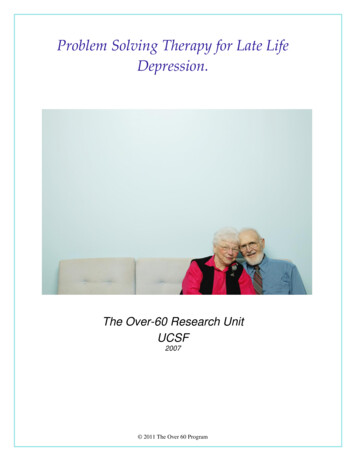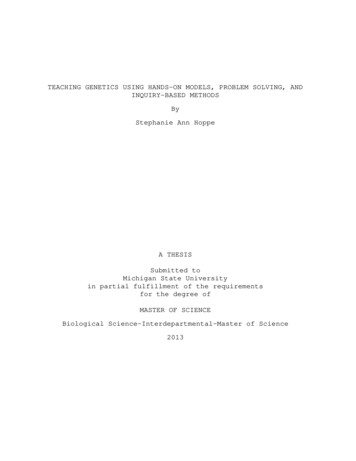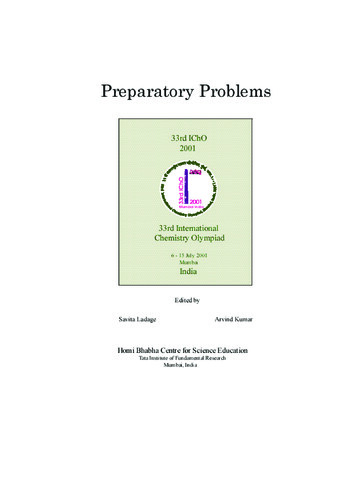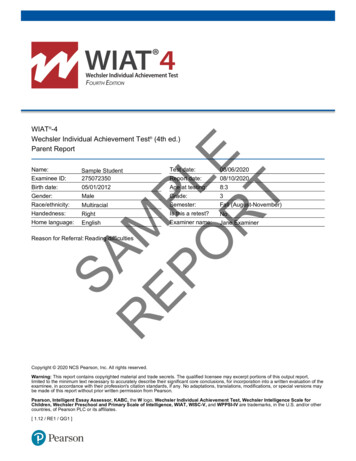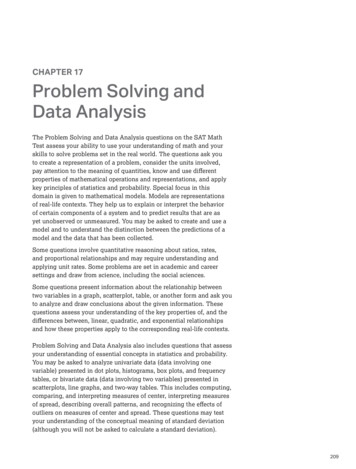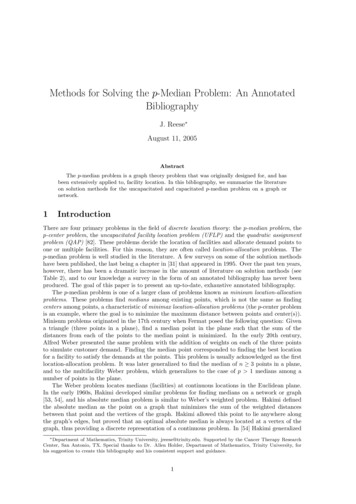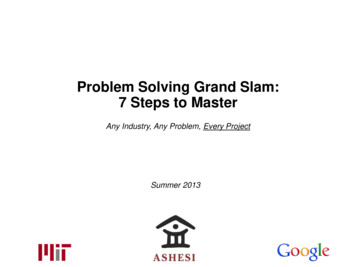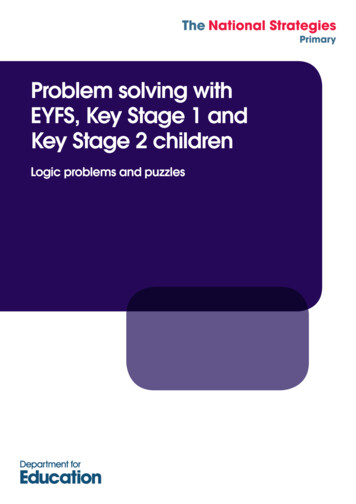
Transcription
Problem solving withEYFS, Key Stage 1 andKey Stage 2 childrenLogic problems and puzzles
Problem solving withEYFS, Key Stage 1 andKey Stage 2 childrenLogic problems and puzzlesFirst published in 2010Ref: 00433-2010PDF-EN-01
DisclaimerThe Department for Education wishes to make itclear that the Department and its agents acceptno responsibility for the actual content of anymaterials suggested as information sources inthis publication, whether these are in the form ofprinted publications or on a website.In these materials, icons, logos, software productsand websites are used for contextual and practicalreasons. Their use should not be interpretedas an endorsement of particular companies ortheir products.The websites referred to in these materials existedat the time of going to print.Please check all website references carefully tosee if they have changed and substitute otherreferences where appropriate.
The National Strategies PrimaryProblem solving with EYFS, Key Stage 1 and Key Stage 2 children:Logic problems and puzzles1ContentsIntroduction3Foundation StageActivity 1: Different shoes5Activity 2: Nature sort8Year 1Lesson 1: Toys11Lesson 2: Granny’s garden17Year 2Lesson 1: Shape puzzle21Lesson 2: Sally’s super sandwich shop26Year 3Lesson 1: Coloured shapes35Lesson 2: Rebecca’s favourite school day41Year 4Lesson 1: Shape puzzle47Lesson 2: Numbers of boys and girls53Year 5Lesson 1: Nicknames59Lesson 2: Tea for two65Year 6Lesson 1: Albert Square72Lesson 2: House points80 Crown copyright 201000433-2010PDF-EN-01
The National Strategies PrimaryProblem solving with EYFS, Key Stage 1 and Key Stage 2 children:Logic problems and puzzles3IntroductionThis resource focuses on problems that fall into the category ‘Logic problems and puzzles’. To helpchildren become good at solving logic problems and puzzles it is important that they are taught andacquire essential skills and strategies and understand how and when to use them.When solving logic problems and puzzles, the strategies children need to be able to draw on include: Identifying carefully what is known and what needs to be found and thinking about how they mightrelate;Looking through the information that is given for any relationships or patterns that can bedeveloped and used;Developing a line of thinking that involves making inferences and deductions, for example ‘if I knowthat then this could or must be true’, and testing these out against the given information;Taking one piece of the information and changing it, while keeping everything else fixed, to seewhat effect it has on the problem;Choosing a way of recording and organising the given information that helps to see how theproblem is structured;Checking answers along the way to see if they satisfy the conditions or rules.There are two lessons for each age group, and a selection of activities for the Early Years FoundationStage. Progression has been built across the two lessons in each year group so that the work in thesecond lesson builds on the work in the first, and also there is progression across years.You should adapt the problems for the needs of your children. For example, in the Year 2 probleminvolving Sally’s super sandwich shop, you could: reduce the numbers of sandwiches involved; change‘double the number’ to ‘one more’; change the type of shop to involve fewer or more good and criteria tobe met.Throughout the lessons, there are notes to indicate particular features that you might want to consider orlook out for when working with children, indicated by the following symbol: Crown copyright 201000433-2010PDF-EN-01
The National Strategies PrimaryProblem solving with EYFS, Key Stage 1 and Key Stage 2 children:Logic problems and puzzles5Foundation StageActivity 1: Different shoesEarly Years Foundation Stage early learning goal Use developing mathematical ideas and methods to solve practical problems.Primary Framework objectives Describe solutions to practical problems, drawing on experience, talking about their own ideas,methods and choices.Sort objects, making choices and justifying decisions.Use developing mathematical ideas and methods to solve practical problems.By the end of this activity, children will be able to: recognise similarities and differences;sort objects using several criteria and sort to their own criteria, justifying their choices;explain what they are thinking and doing.VocabularysamedifferentsortNecessary priorknowledge Different shoesColour and pattern recognition.Language of similarity anddifference.Resources A collection of different typesof shoes. Crown copyright 201000433-2010PDF-EN-01
6The National Strategies PrimaryProblem solving with EYFS, Key Stage 1 and Key Stage 2 children:Logic problems and puzzlesWhole-group or small-group activityWhat’s your shoe?Share stories with the children that refer to shoes, e.g. Cinderella, The Elves and the Shoemaker. Using yourcollection of shoes, draw out the different types of shoes, colours and fastenings that you could have, e.g.boots, sandals, trainers, slip-ons, laces, hook-and-loop tape, and buckles. You may want to give the children ashoe to talk about in pairs.Q. Who has got a shoe that is blue?Q. Who has got a shoe with a buckle?Encourage the children to describe the shoes that they are wearing. Develop sorting activities with thewhole group or small group, e.g. ‘If you have laces, stand up.’ ‘If you have black shoes, stand up.’ ‘If you haveblack shoes and laces, stay standing.’ Encourage the children to check that their shoes do fit the criteria.Encourage the children to use these criteria.This ‘sophisticated sorting’ is very helpful in solving logic problems.Children need to understand that problem solving involves choices,so they have the opportunity to make decisions and justify them.Missing shoesThe scenario is that you have chosen a pair of shoes but unfortunately someone has mixed all the shoesinto a large pile. ‘I have a problem. I have brought a pair of shoes but someone has mixed all the shoesup. Can you be shoe detectives and help me find my shoes?’Q. How could we find my pair of missing shoes?Q. What sort of shoe do you think I might have chosen?Q. What type of shoe might I choose if I was going to the beach/for a walk in the woods/to a party?Say that you will give clues about your shoes.Say that you will give clues about your shoes.Q. My shoes have laces. What shall we do?Agree that you will put all the shoes with laces to one side.Q. My shoes are white; what shall we do now?Q. Are all the shoes we sorted white and do they all have laces?How did the children tackle the problem?Did they understand the problem? Were they able to talk to others?Take a white shoe without laces.Q. This shoe is white. Why can’t it be this one?Here we are ensuring that children understand that the shoesmeet two criteria.00433-2010PDF-EN-01 Crown copyright 2010
The National Strategies PrimaryProblem solving with EYFS, Key Stage 1 and Key Stage 2 children:Logic problems and puzzles7Continue to give descriptions of your shoes so that they find the right pair.Q. What did you find out about my shoes?Encourage the children to recall the different criteria you gave them.‘Yes, my shoes were white with laces and they were trainers. Well done, you solved the problem.’Develop the activity further where the children are encouraged to choose a pair of shoes from acollection and give clues to the other children, so that they find the right pair of shoes. You could buildon this activity and encourage the children to ask questions to try and find out what shoe has beenchosen, e.g. ‘Is the shoe black? Does it have a buckle?’Q. What questions helped us work out what the shoe was?Point out to the children which questions helped them to make the right choice, and those that didn’t help.You could also encourage the children to sort the coins in the till in role-play, or to sort cutlery, plates, cups orcollections of teddies. Link to other sorting activities that will be happening in different contexts and otherareas of learning. Have a collection of different sized parcels in similar and different types of wrapping paperfor the children to sort and discuss. ‘Can you find the parcel that is red and spotty?’ ‘Can you find all the smallgreen parcels?’ Encourage the children to choose a parcel and describe it.If you have the use of an interactive whiteboard, you may want to create a screen with a collection ofobjects and sorting boxes into which the objects can be dragged and dropped. Crown copyright 201000433-2010PDF-EN-01
8The National Strategies PrimaryProblem solving with EYFS, Key Stage 1 and Key Stage 2 children:Logic problems and puzzlesFoundation StageActivity 2: Nature sortEarly Years Foundation Stage early learning goal Use developing mathematical ideas and methods to solve practical problems.Primary Framework objectives Describe solutions to practical problems, drawing on experience, talking about their own ideas,methods and choices.Sort objects, making choices and justifying decisions.Use developing mathematical ideas and methods to solve practical problems.By the end of this activity, children will be able to: recognise similarities and differences;guess the criteria being used to sort objects;make and test hypotheses.Vocabularysamedifferentsortvocabulary linked to knowledge and understanding of the worldNecessary prior knowledge Colour and pattern recognition.Language of similarity and difference.Opportunities to discuss and exploredifferent natural and manufacturedmaterials.Nature sortResources Collections of different objects, bothnatural and manufactured, e.g. toys,toy vehicles.Two hoops and/or yes/no or / , / cards.00433-2010PDF-EN-01 Crown copyright 2010
The National Strategies PrimaryProblem solving with EYFS, Key Stage 1 and Key Stage 2 children:Logic problems and puzzles9Environmental activity (large or small group)It would be useful to take the children on a walk, either around the school grounds or within the localenvironment, in preparation for the class-based activity. Encourage the children to describe what they see.Look at this tree trunk.Q. Do you think it is hard/soft/smooth/rough/shiny?Q. Can you see something else that is brown/hard/soft/smooth/rough/shiny?Encourage the children to record different objects they see, which can be used as a discussion point backin the classroom.Q. Did we see any things that were the same colour?Q. How many did we see that were the same?Q. Did we find anything that was brown and rough?Suggested supportive activitiesHave a class collection of different types of materials for the children to explore, discuss and sort.Create opportunities to produce drawings, paintings, rubbings and collages of objects sorted to a givencriterion.Have a collection of different sized parcels in similar and different types of wrapping paper for thechildren to sort and discuss. ‘Can you find the parcel that is red and spotty? Can you find all the smallgreen parcels?’ Encourage the children to choose a parcel and describe it.If you have a digital camera you could photograph the different objects the children see to record theirfindings. This could be made into a class book.Feely bagExplain to the children that there is a mystery object in the bag and that they are going to work out whatit is. Display a range of objects including a duplicate of the object in the bag as a visual prompt. Ask achild to come forward and feel the object in the bag. They should describe it to the other children, usinga range of vocabulary.Q.Q.Q.Q.How could we find out what is in the bag without looking?Can you describe how it feels?Can we see which object it might be? Is there anything else that is soft? Which objects can’t it be?Can it be the pencil? Why not?Encourage the children to share ideas with a partner. Involve the children insustained shared thinking.Remove to one side the displayed items that are excluded, to help the children to make more informedchoices. Continue with the questioning until the right object has been guessed.Pick out the descriptions that helped the children to work out what the object was.Perseverance and persistence are important problem-solving skills.You may wish to repeat the activity with the children asking questions to find out what is inside the bag. Crown copyright 201000433-2010PDF-EN-01
10The National Strategies PrimaryProblem solving with EYFS, Key Stage 1 and Key Stage 2 children:Logic problems and puzzlesGuess the collectionTell the children a story about how a magpie likes to collect objects and put them in its nest. Get thechildren to share their ideas of what might be the same about all the things the magpie has collected.You could use a puppet or soft toy to act as the magpie.Explain that the magpie wants to make a collection of objects but you are not sure what it wants.Q. What sort of things do you think a magpie might wantto collect?Q. How could we find out what it wants to collect?Explain that the children are going to choose an object and ask the magpie (puppet) whether it wants itin the collection. Place the two hoops down and explain that one hoop will be for the items the magpiewants and the other hoop is for the items it doesn’t want. Label each hoop yes/no or / or / . Ask achild to choose an item and ask the magpie whether it would like the item.Q. What do you think the magpie wants to collect?‘It wanted the spoon but not the pencil.’Q. Can we find anything else that it might like? How are they the same?Q. Do you think the magpie would like the silver tray?Q. Why do you think that?Q. Would it like the book?Q. Why do you think that?How did the children tackle the problem? Did they understand the problem? Didthey begin to make connections between the objects that had been accepted bythe puppet? Are they spotting common characteristics?Continue the activity with the children selecting items and the magpie indicating whether it wants it (if itis shiny) or not.This is encouraging children to develop early problem-solving skills of trial andimprovement.Q.Q.Q.Q.Q.Can we see anything that is the same about all the items in the collection?Can we guess what the magpie likes collecting? How do you know it likes collecting that?Is everything in the collection shiny?Can you think of something else around the class that we could put into the magpie’s hoop?Why does that go in the hoop?The activity could be repeated with the children choosing the criterion for the puppet. You could providematerials for the children to record their findings or photograph the findings.00433-2010PDF-EN-01 Crown copyright 2010
The National Strategies PrimaryProblem solving with EYFS, Key Stage 1 and Key Stage 2 children:Logic problems and puzzles11Year 1Lesson 1: ToysPrimary Framework objective Describe simple patterns and relationships involving numbers or shapes; decide whether examplessatisfy given conditions.By the end of this lesson, children will be able to: solve a problem using given facts;use one piece of information and see what effect it has;check that the answer meets all of the criteria.Vocabularynext totopbottombehindbetweenabovefirstin frontlastNecessary prior knowledge Positional language such as before,after, next to, first, second, etc.Experience of working collaboratively insmall groups.TOYSResources Resource sheet 1Resource sheets 2a and 2bReal toys or clip art of toys to show onan interactive whiteboardModel shelf (e.g. stack of boxes, classshelving).1. The boat is on the middle shelf.2. The skipping rope is on the top shelf.3. The car is on the bottom shelf.4. The ball is next to the boat.5. The teddy is in between the boat and the car. Crown copyright 201000433-2010PDF-EN-01
12The National Strategies PrimaryProblem solving with EYFS, Key Stage 1 and Key Stage 2 children:Logic problems and puzzlesMain teaching activityUse real toys and a stack of five boxes piled on top of each other to introduce the problem of placing thetoys on the shelves on Resource sheet 1.A story could provide a good context.The ‘shelf’ could contain objects relevant to any topic, e.g. sea creatures, transport.Q. Where do you think each toy should go? Why do you think that?Explain that the toys must be put in special places and that you have some clues to help them work outwhere each toy must go.Introduce the clue cards from Resource sheet 1 one at a time:Using given facts in order to solve a problem is a key skill in solving logic problems. This activityintroduces the concept as ‘giving clues’.Read card 1, ‘The boat is on the middle shelf.’Q. What is the helpful word in this clue card?Draw out the positional word ‘middle’.Invite a child to use the clue to place the boat in the correct place. Continue through clues 2 and 3.Read card 4, ‘The ball is next to the boat.’Q. What are the helpful words on this card?Draw out the words ‘next to’.Q. Is there more than one place that the ball could go?Model the trial and improvement process by placing the ball in one of the possible places and thenexplain that the next clues might help to find the final place.When looking at card 5, ‘The teddy is in between the car and the boat’, demonstrate how that clue helpsto locate the position of the teddy and also the ball.Q. Did we need all of the clues?Q. What would happen if you lost one of the clues?Model the checking process by going through each clue card and checking that the position of the toysmeets the criteria on the cards.Pose some more questions to reinforce the positional vocabulary, e.g.Q. What is in between the skipping rope and the boat? Is it the only toy?Display the key positional vocabulary on the board for the children to refer to later.Split the class into mixed-ability groups of five. Each group will need a blank bus queue, five charactercards and five clue cards from Resource sheet 2. Explain that they will now have a similar problem tosolve as a group, using clues to place the characters in the correct place in a bus queue. Each child in thegroup will have one clue each. They will be expected to contribute their clue to the group to help solvethe problem. Ask the children to read their clues in pairs and to discuss what information it gives them,but not to place any characters at the moment.How is the mixed-ability group work supporting the children?00433-2010PDF-EN-01 Crown copyright 2010
The National Strategies PrimaryProblem solving with EYFS, Key Stage 1 and Key Stage 2 children:Logic problems and puzzles13Drawing togetherDraw the class together in order to reflect on the effect of different clues.Q. How is your clue helpful?Q. Could you place a character using your clue?Q. Why can’t you put Billy Goat into the queue straight away?Pursue the conversation to assess children’s understanding, using questions suchas ‘How do you know that?’ ‘Why do you think that?’Remind the class to take turns to listen to each clue in turn in order to solve the group problem.PlenaryUse a large version of the characters, the queue and the clues to review children’s solutions to theproblem and check the final solution against the clues.Children need to be encouraged to make up their own ‘What if . . . ?’ questionsas part of the development of their reasoning skills.Introduce a new character, Mr Wolf, who joins the queue somewhere in the middle (see Resource sheet 2b).Q. If the wolf stands here in the queue, then which clues are still true and which are now false?Q. If the wolf stands here, then where are the characters standing now?Invite the children to offer alternative changes to the queue and suggest how the clues change, e.g. ifanother little pig joins the end of the queue then Red Riding Hood isn’t at the end any more. Crown copyright 201000433-2010PDF-EN-01
14The National Strategies PrimaryProblem solving with EYFS, Key Stage 1 and Key Stage 2 children:Logic problems and puzzlesYear 1, Lesson 1: resource sheet 1TOYS1. The boat is on the middle shelf.2. The skipping rope is on the top shelf.3. The car is on the bottom shelf.4. The ball is next to the boat.5. The teddy is in between the boat and the car.00433-2010PDF-EN-01 Crown copyright 2010
The National Strategies PrimaryProblem solving with EYFS, Key Stage 1 and Key Stage 2 children:Logic problems and puzzles15Year 1, Lesson 1: resource sheet 2aBusStopLittle RedRiding HoodLittle PigBilly GoatDaddy BearGingerbreadBoy1. Little Red Riding Hood is last in the queue.2. Billy Goat is next to Daddy Bear.3. Gingerbread Boy is first in the queue.4. Little Pig is behind Gingerbread Boy.5. Daddy Bear is in the middle of the queue. Crown copyright 201000433-2010PDF-EN-01
16The National Strategies PrimaryProblem solving with EYFS, Key Stage 1 and Key Stage 2 children:Logic problems and puzzlesYear 1, Lesson 1: resource sheet 2bBusStopLittle RedRiding HoodLittle PigBilly GoatDaddy BearGingerbreadBoyMr Wolf1. Little Red Riding Hood is last in the queue.2. Billy Goat is next to Daddy Bear.3. Gingerbread Boy is first in the queue.4. Little Pig is behind Gingerbread Boy.5. Daddy Bear is in the middle of the queue.00433-2010PDF-EN-01 Crown copyright 2010
The National Strategies PrimaryProblem solving with EYFS, Key Stage 1 and Key Stage 2 children:Logic problems and puzzles17Year 1Lesson 2: Granny’s gardenPrimary Framework objective Describe simple patterns and relationships involving numbers or shapes; decide whether examplessatisfy given conditions.By the end of this lesson, children will be able to: solve a problem using given facts;use one piece of information and see what effect it has;check that the answer meets all of the opbottomNecessary prior knowledge Positional language such as next to, inbetween.firstlastin frontbehindcircleGranny‛s garden2D shape recognition.carrotsExperience of using clues to helpsolve problems.peasResources Resource sheet 1potatoesA selection of vegetables or clipart of vegetables on an interactivewhiteboard.cabbagesbeans1. Granny grew carrots in a triangle.2. Granny grew peas in a square.3. Granny grew potatoes in a circle.4. Granny grew cabbages next to her house.5. Granny grew beans in an oblong. Crown copyright 201000433-2010PDF-EN-01
18The National Strategies PrimaryProblem solving with EYFS, Key Stage 1 and Key Stage 2 children:Logic problems and puzzlesMain teaching activityIntroduce the problem using a large version of the garden from Resource sheet 3 and the selection ofvegetables. Explain that the task is to place the vegetables in the correct places in the garden.Q. What will you need in order to help you to work out where each vegetable will go?Remind the class that in the last lesson they used clues in order to solve the problem.Q. What did the clues do?Q. How were some clues more helpful than others?Q. Were all of the clues important? Why?Ask children to work in pairs to look at the clues and decide which vegetables they can place straightaway. They should sort them into two piles: those vegetables which can be placed straight away andthose which have more than one possible place.Allow several minutes for independent work.Paired work gives more opportunity for children to develop their reasoning andcommunication skills.You might want to link the problem with work on The Enormous Turnip. Alternative contexts might be touse different types of counters or cars in a car park.Drawing togetherQ.Q.Q.Q.Which vegetables can you place straight away? Why?Which clues need some more information?Can you pair any clues together?Which clue do you need to save until last?Respond to any difficulties or misconceptions observed as the children worked independently, e.g. ifassumptions were made about the position of the peas.Ask children to continue working in pairs to solve the problem.Drawing togetherAsk children to share their solutions with another pair.Q. What will you do if you have different answers?Q. How will you know that you are right?Encourage children to check their solution against the clues. Allow a further few minutes for discussionof solutions between partners.Checking against the given information and justifying decisions is an importantskill, which needs modelling at this age.00433-2010PDF-EN-01 Crown copyright 2010
The National Strategies PrimaryProblem solving with EYFS, Key Stage 1 and Key Stage 2 children:Logic problems and puzzles19PlenaryDraw the class together in order to check the solution against the clues.Q. Which clue was the most helpful?Q. Why couldn’t you place the cabbages or peasstraight away?Q. What did you do?Q. Which clue helped you to place the peas?Move the vegetables into different positions. Invite children to verbally offer their own clues to describewhere the vegetables are now placed. Write these on the board and then check the position of thevegetables against them. Crown copyright 201000433-2010PDF-EN-01
20The National Strategies PrimaryProblem solving with EYFS, Key Stage 1 and Key Stage 2 children:Logic problems and puzzlesYear 1, Lesson 2: resource sheetGranny‛s gardencarrotspeaspotatoescabbagesbeans1. Granny grew carrots in a triangle.2. Granny grew peas in a square.3. Granny grew potatoes in a circle.4. Granny grew cabbages next to her house.5. Granny grew beans in an oblong.00433-2010PDF-EN-01 Crown copyright 2010
The National Strategies PrimaryProblem solving with EYFS, Key Stage 1 and Key Stage 2 children:Logic problems and puzzles21Year 2Lesson 1: Shape puzzlePrimary Framework objectives Describe patterns and relationships involving numbers or shapes, make predictions and test thesewith examples.Identify and record the information or calculation needed to solve a puzzle or problem; carry out thesteps or calculations and check the solution in the context of the problem.By the end of this lesson, children will be able to: solve a problem by identifying given facts and prioritising them;confirm that they have found the correct solution by checking in another sary prior knowledge Add and subtract mentally.Number bonds for numbersup to 20.Recognise the use of a symbol tostand for an unknown number.Resources Resource sheet 1Shape puzzleEach shape stands for a number.The numbers shown are the totals of the line of threenumbers in the row or column.Find out which number each symbol represents andfind the other totals.Resource sheet 2.121420 Crown copyright 2010600433-2010PDF-EN-01
22The National Strategies PrimaryProblem solving with EYFS, Key Stage 1 and Key Stage 2 children:Logic problems and puzzlesMain teaching activityWrite the number sentence 10 20 on the board. Read it together, saying: ‘10 plus somethingequals 20.’ Ask the children to work in pairs to complete the number sentence on whiteboards.Q. How did you work it out?Some children will know this as a double and others may have counted on from 10.This activity is preparing children for the main problem.Repeat with other problems, e.g.2 2 1 15 10If children find it difficult to understand the idea of a symbol representing a number, write the completenumber sentences and cover numbers with shapes instead. Say that if there are three squares, thenumbers underneath them are the same.Q. How is this last one different?Draw out that the symbols are different and so the numbers are different.Q. Can we work out the answer? What could be?So what could be?Are there any other possibilities?Ensure that children are using the mental strategy of lookingfor pairs of numbers that total 10.Write: 8Q. What is ? If is the same number in 10, what is?Show Resource sheet 1 and explain that each symbol represents a number and they have to find outwhat the numbers are.Ask children to discuss in pairs how they might start to solve the problem.Allow some time for children to ‘get their heads around the problem’.Drawing togetherQ. Which is the most important row or column? Why?Agree that the column with the three triangles is the most important because it includes only one shapeand the total was given and so we can find out what the triangle represents.Prioritising information is an important skill when solving logic problems.Write: 6 and ask the children to work out what the triangle represents. Agree that it is 2.Q. Which column or row should we try next? Why?00433-2010PDF-EN-01 Crown copyright 2010
The National Strategies PrimaryProblem solving with EYFS, Key Stage 1 and Key Stage 2 children:Logic problems and puzzles23Agree that either the top row or the second row could be done next because in each the total is givenand we know what the triangle represents.Work through row 1. Write: 12Q. What is ?Q. So if two hearts and a triangle make 12, what do two hearts make?Write: 10Agree that two hearts make 10, so one heart must be half of 10.Q. So what does the heart represent? (5)Q. Which row or column could help us to find the pentagon?Q. Which row or column could you use to check the pentagon?Agree that they could use column 1 or row 2 to find the pentagon and use the other to check.Ask the children to find the pentagon and then to complete the missing totals.If some children finish this quickly then set them the following problem:Add one shape to each row so that each row has a different total, less than 25. Use each shape once.Establish that we now know what all the symbols represent and so the whole problem can becompleted. Ask the children to complete the grid.PlenaryQ. What information helped you to solve the problem?Ask the children to discuss this in pairs.Establish that the problem gave:1. the total of three triangles so we could work out the triangle;2. the total of only triangles and a pentagon so we could work out the pentagon;3. the total of only hearts and a triangle so we could work out the heart;4. the total of only hearts a
Logic problems and puzzles. Problem solving with EYFS, Key Stage 1 and Key Stage 2 children Logic problems and puzzles First published in 2010 Ref: 00433-2010PDF-EN-01. Disclaimer. The Department for Education wishes to make it . Checking answers alon
